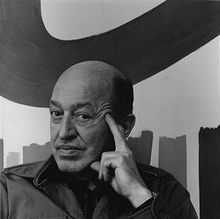Clement Greenberg facts for kids
Quick facts for kids
Clement Greenberg
|
|
|---|---|
 |
|
| Born |
Clement Greenberg
January 16, 1909 New York City, U.S.
|
| Died | May 7, 1994 (aged 85) New York City, U.S.
|
| Education | Syracuse University (AB) |
| Movement |
|
Clement Greenberg (January 16, 1909 – May 7, 1994) was an important American art critic. He wrote a lot about modern art in the mid-1900s.
Greenberg is best known for supporting the art movement called Abstract Expressionism. He was especially connected to the painter Jackson Pollock. Sometimes, Greenberg wrote under the name K. Hardesh.
Contents
Early Life
Clement Greenberg was born in the Bronx, New York City, in 1909. His parents were immigrants. He was the oldest of three sons.
When he was a child, Greenberg loved to sketch. As he grew older, he became more interested in literature. He went to Syracuse University and graduated in 1930.
Greenberg already knew Yiddish and English well. After college, he taught himself Italian and German. He also knew French and Latin. For a few years, he worked for his father's business. But he didn't like it much. So, he started working as a translator.
In 1936, Greenberg began working for the government. Around this time, he also started writing seriously. Soon, his writings appeared in magazines and journals.
"Avant-Garde and Kitsch"
Even though he first wrote about literature, art always interested Greenberg. In 1939, he became famous as an art writer. This happened when he published his essay, "Avant-Garde and Kitsch". It first appeared in a journal called Partisan Review.
In this essay, Greenberg talked about two types of art. He said that true avant-garde art is new and experimental. It challenges common ideas. This art tries to stay pure and separate from popular culture.
On the other hand, Greenberg described "kitsch" art. Kitsch was made for many people to enjoy easily. It was often simple and sentimental. He believed kitsch was used to create false feelings. Avant-garde art, he said, was too "innocent" to be used for propaganda.
Art History and Abstract Expressionism
Greenberg wrote many important essays about 20th-century art. In 1940, he became an editor for Partisan Review. He also became an art critic for the Nation in 1942.
After World War II, Greenberg believed that the best new artists were in America. He strongly supported Jackson Pollock. Greenberg called Pollock the greatest painter of his time. He admired Pollock's "all-over" style of painting.
In 1955, Greenberg wrote an essay called "American-Type Painting." In it, he praised Abstract Expressionism. He saw artists like Willem de Kooning and Barnett Newman as the next step in modern art. He argued that these painters focused more on the "flatness" of the canvas. This meant they emphasized the two-dimensional surface, not trying to create an illusion of depth.
Greenberg also talked about "medium specificity." This idea means that each art form has its own special qualities. For painting, its unique quality is being flat. Modernist painters, he believed, should focus on this flatness.
Greenberg also supported artists outside the U.S. He was impressed by Canadian painters William Ronald and Jack Bush. He became good friends with Bush. Greenberg saw Bush's later work as a move from Abstract Expressionism to Color Field painting.
Greenberg had mixed feelings about pop art. He thought it was clear and open. But he also felt it didn't truly challenge people's taste.
In the 1960s, Greenberg was still very influential. But some critics thought his ideas were "old fashioned." They felt he didn't like new art movements like Postmodernism.
The writer Tom Wolfe criticized Greenberg in his book The Painted Word. Wolfe said that critics like Greenberg had too much power in the art world.
Post-Painterly Abstraction
Greenberg eventually felt that some Abstract Expressionism had become too predictable. He started looking for new artists. These artists moved away from strong brush strokes and clear subjects.
Greenberg called this new style Post-Painterly Abstraction. He used this term to separate it from Abstract Expressionism. This new art reacted against the wild, gestural style of earlier Abstract Expressionists.
Two main types of Post-Painterly Abstraction were:
- Hard-Edged Painters: Artists like Ellsworth Kelly and Frank Stella used sharp, clear shapes and edges.
- Color-Field Painters: Artists like Helen Frankenthaler and Morris Louis poured thin, watery paints onto unprimed canvases. They explored large areas of pure, bright color.
These movements continued the idea of modern art constantly looking at itself.
Clement Greenberg Collection
In 2000, the Portland Art Museum (PAM) received the Clement Greenberg Collection. This collection has 159 artworks. It includes paintings, prints, drawings, and sculptures. These works are by 59 important artists from the late 1900s and early 2000s.
Most of the artists are American, but some are Canadian or from other countries. Some artists in the collection include: Jack Bush, Anthony Caro, Helen Frankenthaler, Hans Hofmann, Kenneth Noland, Jules Olitski, Jackson Pollock, and David Smith.
Greenberg's wife, Janice van Horne, gave his library to the Portland Art Museum. This library has many books and catalogs about the artists in his collection. Anyone can visit the library at the museum.
See also
 In Spanish: Clement Greenberg para niños
In Spanish: Clement Greenberg para niños

